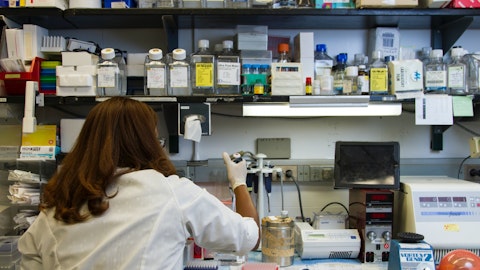Emil Kakkis: Sure. So the way the trial was done it was an event-driven. That is the unwinding of the original final primary analysis is driven by having 100% of the fractures required to achieve the information needed. So they’re event-driven. And the original idea certainly the area is to look at 60% and 80% of that maximum. Assuming a large treatment effect we think we could hit persuasive statistical significance at maybe just 60% of the fractures required is the separation of the two is as high as 67% as noted. So it really depends on the number of fractures and the number of patients and the time of exposure. So, it’s a complex of those three points. So, originally the 100% is expected to be somewhere between 12 and 24 months of the last exposure — last patient in and this would be less than that.
But we expect that we would want to see at least nine months of data of treatment for the last patient in was our expectations. So, it will be fracture-dependent, but we would expect to see at least nine months of data from the last patient in — last nine months of exposure to the last patient in as a minimum.
Unidentified Analyst: Thanks so much.
Emil Kakkis: Yes, the pricing reimbursement question. Well, obviously, romo is out there labeled for osteoporosis has a certain price point. It’s actually at a lower dose with the way it’s used and what we’re doing is actually in a much higher dose and will be optimized for OI. So, you have to think about the dose differential for the two indications as one feature. The other of course is that our treatment will be chronic. And so the question people will have with the shorter term treatment regimen, whether they should take romo longer when it hasn’t been given longer right? I think that becomes more of a barrier question about safety. And we’ll have in fact the chronic data to show our drug can given that way. We’re going to think hard about our pricing strategy.
As you know we’ve had a — we’re a company that looks at more moderated responsible pricing as we did for Crysvita. We think that would make the differential between it and romo substantially less. And given the dose differential would make it I think a not significant issue for the program. And given our support systems our delivery home infusion home delivery of drug as we’ve done for Crysvita for like 85% of the patients, there are going to be a lot of features that will help make this a lot more approachable for our rare disease patients that I don’t think they’ll get support from. So, those are all factors I think and how it will play out. But we’re really knowledgeable about the space because Eric and his team has been commercializing and 90% of those stocks we commercialize Crysvita to are also treating OI right?
There’s a 90% overlap. So, we really know who they are. We have a strong relationship and that will put us in a good position I think to compete. And in our view we’ll have the label. We’ll have the best antibody. We have the right dosing, right regimen, the right team to commercialize.
Unidentified Analyst: Thanks so much.
Operator: Thank you. Our next question comes from Yaron Werber with TD Cowen. You may proceed.
Yaron Werber: Great. Thanks guys for taking the questions. First, I think a quick one from us. Really kind of looking ahead to your first half of next year. Obviously you’re going to have a pretty busy six months it looks like. So, any sense that you can maybe give us on kind of the cadence of when to expect — even if it’s just kind of relative one before the other would be super helpful? And then one quick one on GSD1a. Sorry if I missed this, but has FDA kind of given you any indication? Or do you already have a sense of how long after the topline readout you really need to continue to follow these patients. Really just trying to understand when you might be able or in a position to file potentially launch with 401 of the data looks good. So, thanks very much.
Emil Kakkis: The cadence of findings we actually have a table that has some of it. I have to say we’ve generally not provided extremely precise target of catalysts for various reasons. It is a busy first half. Buckle your seatbelt it’s going to be fun. It’s going — we’re going to have a lot of good work and coming out for you. But I don’t think we — I can give you a blow-by-blow exactly when all it’s going to happen. But we’ll have a table that will give you at least some ideas and it will be a fun quarter. I’m looking forward because we have so many working programs and we’re in such a good position. It will be great to see how they’re doing and be able to talk to you about them. Now, the question on GSD1 is how long to file.
The agreement with FDA is that we could file with 48 weeks of primary data and including the long-term extension data from Phase 1/2 patients, which are now out like five years, so there’s quite a bit of data there. So we think we have a lot of long-term durability data in hand. But keep in mind that the trial enrolled over a period of a good part of the year. So even if we have 48 weeks from the last patient There probably be up to a couple of years of data in the very earliest patients by the time we file, right? So I think I would expect us to be able to file within a reasonable timeframe. There may be other factors that we’ll have to discuss with regard to the rest of the package and filing but we’ll be working to try to file as promptly as we can once we get all the pieces together.
Yaron Werber: All right, great. Thanks very much.
Operator: Thank you. One moment for question. Our next question comes from Joel Beatty with Baird. You may proceed.
Unidentified Analyst: Thanks for the update. For the Ultragenyx spinout, what’s the latest plan and timing and how much ownership does Ultragenyx plan to maintain?
Emil Kakkis: Well, we do have a term sheet signed and a group of investors we’ve put together that we’re filling out that syndicate. I can’t tell you more yet about the details but — our expectation is for Ultragenyx to own the majority interest in the spinout. A majority interest in a spinout based on what we had expect — but — it’s not been finalized and I wouldn’t want to provide any more detail until we get closer. But it’s moving along. We have a lot of interest. The Analyst Day also brought out some new interest. I think there’s a lot of belief that the Mab micros against Amyloid-β, but there’s, also a lot of room for improvement for something better. And we think this is one good option for how you might do a better treatment. So we’ll put out more information we get there but we don’t a majority interest and we’ll hopefully to fill out that team and get that finance half much before the end of the year is our goal.



